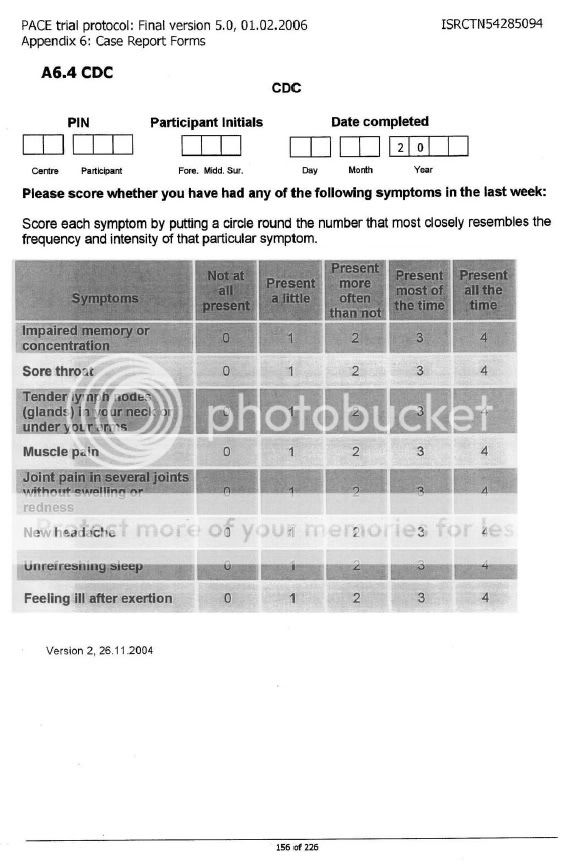I know that people like Angela Kennedy have been complaining about the use of the London criteria in the PACE Trial for many years so I don't claim I am saying anything novel; however, I just thought I'd post my thoughts/observations for what they are worth.
-------------
PACE Trial - 97% of the participants who didn't have a psychiatric disorder satisfied the definition of M.E. used
In the Lancet paper on the PACE Trial (by White et al (2011)), it said:
----------
I was not 100% sure what "no primary depressive or anxiety disorder (interpreted as an absence of any such disorder)" meant in relation to the percentage we were given for "any psychiatric disorder" i.e. could there be an overlap.
The following is an extract of a letter that clarifies it (see underlined bit in bold) - the letter was written by PD White, KA Goldsmith, AL Johnson, R Walwyn, HL Baber, T Chalder, M Sharpe, on behalf of all the co-authors (of the PACE Trial)
---------
(source: http://www.meactionuk.org.uk/whitereply.htm )
-------
The figures from the paper (Table 1) show that, of the 640 participants, 300
(46.9%) had "any psychiatric disorder" and 51.4% (329) satisfied the London criteria*.
This means that of the 340 patients in the trial (i.e. who satisfied the Oxford criteria**, with a principal symptom of fatigue, who did not have a psychiatric disorder), 329 (96.8%) satisfied the London criteria for M.E., the definition of M.E. used in the trial!
This is an amazingly high figure for a definition of M.E. given the "looseness" of the Oxford criteria e.g. unlike the Fukuda CFS criteria or Carruthers ME/CFS criteria, it doesn't require other symptoms apart from fatigue.
It seems to me the definition for M.E., at least as it was used in this trial, is very suspect. And hence it is questionable what can read into how people with M.E. responded in the trial.
---
*One can how the London Criteria were used here:

**
One can how the Oxford Criteria were used here:

Annex 1:
We already cannot be sure if the participants are representative of patients in the community based on who refused to take part, were excluded, etc.
-------------
PACE Trial - 97% of the participants who didn't have a psychiatric disorder satisfied the definition of M.E. used
In the Lancet paper on the PACE Trial (by White et al (2011)), it said:
----------
-----------"Participants were also assessed by international criteria for chronic fatigue syndrome,12 requiring four or more accompanying symptoms, and the London criteria13 for myalgic encephalomyelitis (version 2), requiring postexertional fatigue, poor memory and concentration, symptoms that fluctuate, and no primary depressive or anxiety disorder (interpreted as an absence of any such disorder)."
I was not 100% sure what "no primary depressive or anxiety disorder (interpreted as an absence of any such disorder)" meant in relation to the percentage we were given for "any psychiatric disorder" i.e. could there be an overlap.
The following is an extract of a letter that clarifies it (see underlined bit in bold) - the letter was written by PD White, KA Goldsmith, AL Johnson, R Walwyn, HL Baber, T Chalder, M Sharpe, on behalf of all the co-authors (of the PACE Trial)
---------
The trial did not study ME/CFS (pages 12-18)
The selection of patients was for CFS operationalised using the broadest criteria (the Oxford criteria). No sensible neurologist would apply the diagnosis of CFS (or indeed ME) to patients who had "proven organic brain disease", such as Parkinson's disease. For the purposes of this trial ME was not regarded as a "proven organic brain disease". In order to ensure balance between the trial arms in those participants who met alternative criteria for CFS and ME, randomisation was stratified by the International (Centers for Disease Control) criteria (which require additional symptoms) and by the London ME criteria (based on Melvin Ramsay's original description, and which excludes co-existing "primary" psychiatric disorders [which we interpreted as any psychiatric disorder] and emphasises post-exertional fatigue). We were provided with the second revised version of the London ME criteria; we did not invent our own. We considered use of the Canadian criteria for ME but we found it impossible to operationalise them adequately for research purposes; to our knowledge they have not been used in a major research trial. We studied the results for differently defined subgroups and they were similar to those in the entire group.
(source: http://www.meactionuk.org.uk/whitereply.htm )
-------
The figures from the paper (Table 1) show that, of the 640 participants, 300
(46.9%) had "any psychiatric disorder" and 51.4% (329) satisfied the London criteria*.
This means that of the 340 patients in the trial (i.e. who satisfied the Oxford criteria**, with a principal symptom of fatigue, who did not have a psychiatric disorder), 329 (96.8%) satisfied the London criteria for M.E., the definition of M.E. used in the trial!
This is an amazingly high figure for a definition of M.E. given the "looseness" of the Oxford criteria e.g. unlike the Fukuda CFS criteria or Carruthers ME/CFS criteria, it doesn't require other symptoms apart from fatigue.
It seems to me the definition for M.E., at least as it was used in this trial, is very suspect. And hence it is questionable what can read into how people with M.E. responded in the trial.
---
*One can how the London Criteria were used here:

**
One can how the Oxford Criteria were used here:

Annex 1:
We already cannot be sure if the participants are representative of patients in the community based on who refused to take part, were excluded, etc.

